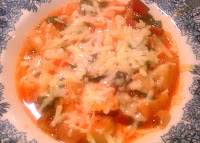There's a ridiculously large variety of GF products out there, some are good and some are not so good. With all the products on the market I think we are going to see a a Darwinian reduction in the next few years as the best products succeed, but for now we're stuck being beta-testers. I decided to list some items that have made me happy.
COOKIES
As I age, my metabolism dips and my muscle mass reduces, so has by reduction in sweet snacks. I never totally deny myself, so when I just need something sweet, this is what I like to eat.
Kinnikinnick Foods, S'moreables, Graham Style Crackers

I give these an OMG ratin
g! These are better than the originals.
The first time I bought S'moreables was to make a
GF graham cracker base for a pumpkin pie last Thanksgiving. I don't think anyone paid attention to the pumpkin part, but the base was to die for!
Bonus - They are dairy-free, nut.free and contain no preservatives!
Honorable Mention
Newsman's Own Gluten free and Dairy Free Oreo Cookies
Some people say they are not as good as the originals...I say, they're in my pantry, they're gluten free and I can eat them!
BREAD
Bread is the most difficult area to find something French-bread-crunchy, chewy-fresh and satisfying. I don't think I have found anything GF that is better than the real thing, but I have found some good substitutes.
Udi's Bagels
I know there are purists out there who will disagree, but I'm not comparing to fresh bagel shop versions. I'm comparing GF Udi's to wheat off the shelf prepackaged bagels. I think Udi's had done a fantastic job...they are not so dense, they're lightly chewy (unheard of in GF land), they freeze well and they make me forget I can't have warm bagel shop versions.
Honorable Mention
Julian Bakery Smart Carb GF #3
This is nothing like wheat gluten bread. It's a small brick; exactly what you would expect for a GF bread product. But this loaf has a wonderful bready smell, and when toasted and spread with butter (or Natural Balance) it is crunchy and wholesome. I toast slices and use it like a cracker for lunch! When toasted and eaten with soup, it is comfort food. This is one of those products that I would eat whether I needed gluten-free or not....I just like it and it makes me happy!
Bonus - It is the lowest carbohydrate bread out there, it's also yeast free and organic!
Udi's GF Bread
This is not bad, it can be used for sandwiches and works okay for grilled cheese.
Disappointing
I haven't found any burger buns that I really like (not even Udi's), most are dry and fall apart. The best I have found is an Udi's bagel without a hole! You have to rummage through the display to find what some people call rejects :-)
I've started making my own with
coconut flour and almond flour and will continue to do so until I find a commercial product that that doesn't crumble the second you bite into it. C'mon guys, get with the program!
PASTA
Nothing compares to fresh pasta, but given the choice of brown rice or Quinoa (
keen-wa), I'll choose Quinoa every time!
 Ancient Harvest Quinoa Pasta
Ancient Harvest Quinoa Pasta
It lakes a little longer to cook and looks a little darker than regular pasta...but when it's coated in pesto or smothered in marinara it's pretty darn close to the real thing.
Bonus - It has more protein and fiber than regular pasta.
Disappointing
I haven't been able to find a Quinoa Ravioli, or lasagna sheets.
MEAL SUBSTITUTE BARS
By bars I mean power bars, fruit bars, those items you pick up when you're on the run, traveling and don't have time to stop and eat or don't know when you'll have the chance to eat (not candy bars). I rely on nuts and bars a lot when I'm traveling. I'm not a fruit bar (fruit roll-po) kind of girl so I'm not sure I really have a favorite bar. I've listed a selection of the ones I like and can
tolerate;
Enjoy Life - Chewy on-the-go Bars
They are very allergy friendly and have saved my life in Airports where burgers and pizza are the only choices available.
Odwalla Nourishing Food Bar (not GF)
These are not gluten free, due to the fact they are made on equipment that is used for products that contain wheat, milk, eggs and tree nuts. However, many of their bars do not contain any wheat products so I can tolerate them. If you can tolerate oats these may be okay for you too. Their Choco-walla is a favorite of mine...I have frantically searched though my luggage after many a post midnight hotel check-in to find this life-saving midnight dinner treat.













































